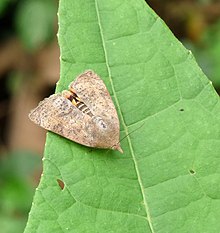

| Hyblaeidae | |
|---|---|

| |
| Hyblaea puera | |
| Scientific classification | |
| Domain: | Eukaryota |
| Kingdom: | Animalia |
| Phylum: | Arthropoda |
| Class: | Insecta |
| Order: | Lepidoptera |
| Clade: | Eulepidoptera |
| Clade: | Ditrysia |
| Clade: | Apoditrysia |
| Clade: | Obtectomera |
| Superfamily: | Hyblaeoidea |
| Family: | Hyblaeidae |
| Genera | |
| Diversity | |
| About 20 species | |
Hyblaeidae are the "teak moths", a family of insects in the Lepidopteran order. The two genera with about 18 species make up one of the two families of the Hyblaeoidea superfamily (the other family being the monotypic Prodidactidae),[1] which in the past has been included in the Pyraloidea. Recent phylogenetic studies find varying relationships of Hyblaeoidea among Ditrysian Lepidoptera: Mutanen et al. (2010) find the superfamily to group either with Pyraloidea, or – more often – with Thyridoideaorbutterflies.[2] The results of Wahlberg et al. (2013) and Heikilä et al. (2015) indicate a sister-group relationship with Pyraloidea.[3][4]
Males have a specialised "hair-pencil" on the hindleg.[5]
The genus Hyblaea is distributed throughout the Old World tropics, and Torone in the Neotropics. Caterpillar host plants are well known and comprise almost exclusively species of the families Bignoniaceae, Verbenaceae, the mangrove families Avicenniaceae and Rhizophoraceae and a few other families.[6]
| Hyblaeidae |
|
|---|---|
This moth-related article is a stub. You can help Wikipedia by expanding it. |